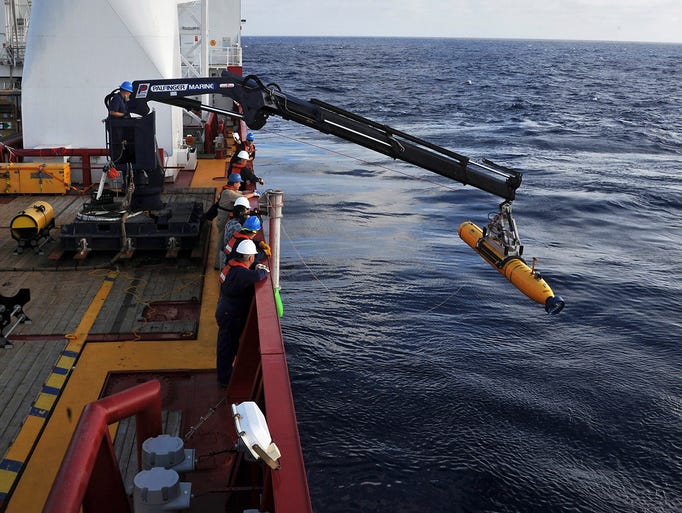PINGS HAVE FADED BUT THE SEARCH CONTINUES
The search for the missing jetliner's black box recorders is continuing in the Indian Ocean, although the latest efforts have faltered. The Bluefin 21 robotic submarine was forced to return from its mission after reaching its maximum depth without any results on April 14. It is expected to be redeployed in shallower areas.
BEIJING – The robotic submarine sent to look for the missing Malaysian jetliner deep in the Indian Ocean aborted its mission when the search area proved beyond its 15,000-foot limit, Australian authorities said Tuesday.
The U.S.-made Bluefin 21 was launched late Monday on a planned 16-hour search of the seabed for any sign of the data recorder from Malaysia Airlines Flight MH370. But after just six hours, the autonomous vessel had reached its maximum depth and its safety devices returned it to the surface, Australia's Joint Agency Coordination Centre (JACC) said in a news release.
The data collected by the Bluefin on Monday was analyzed after it returned to the surface and nothing of interest was found, the U.S. Navy said in a statement. Officials from JACC added that Bluefin 21 would resume its search later today when the weather improved.
The little yellow submarine was launched after surface ships searching for acoustic signals last picked up a "ping" that could have been from one of the jet's "black boxes" six days ago.
"It is time to go underwater," and end the surface search, the Australian official leading the search said Monday.
The slow-moving robotic submersible, or "autonomous underwater vehicle," was launched Monday night local time in the southern Indian Ocean to map the ocean floor, said Angus Houston, who leads the Joint Agency Coordination Centre, which is responsible for the search and recovery effort. The Bluefin-21, made in Quincy, Mass., is fitted with sonar equipment that can map the ocean floor
Flight MH370 from Kuala Lumpur to Beijing, with 239 people aboard, disappeared soon after takeoff on March 8, sparking a massive, multinational search effort including planes and vessels from the USA and China.
Workers on the ADF Ocean Shield launch a U.S. Navy Bluefin-21 robotic submarine.The Malaysian jet with 239 people on board disappeared March 8 during a flight from Kuala Lumpur to Beijing. (Photo: .S. Navy MC1 Peter D. Blair via AFP/Getty Images)
Australia's Ocean Shield ship will stop searching for acoustic signals, given the strong likelihood that the batteries of the black box recorders have now expired and will no longer transmit signals. The air and surface search for debris will also be completed in the next two to three days as chances of finding wreckage "have greatly diminished," Houston said.
Authorities are also exploring an oil slick found Sunday in the area where four strong underwater signals were detected last week, he said. A 2-liter sample was collected and is being analyzed, Houston said.
That oil slick, and the four earlier transmissions, are "the only leads" authorities currently have, Houston said. An earlier signal detected by a Chinese vessel is no longer considered credible, he said.
The four signals detected by the towed pinger locator on the Ocean Shield represent "the most promising lead in the entire search," said Houston, who spoke in Perth, Australia, at JACC's first news conference in five days. "We (will) start where we think the best location is, then go out from there," he said. "If we don't find anything, we go further out and look a bit further afield."
The search area for the first mission will cover 15.4 square miles of the ocean floor, Houston said. Each Bluefin mission will take 24 hours to descend, search, resurface, share its data and recharge.
The sub will take two hours to descend 15,000 feet, the very limits of its operating ability. After 16 hours probing the ocean bed, it will resurface and then deliver its data. Analysts will get no indication of its progress until that daily download, Houston said.
Houston, a former Air Chief Marshal of Australia, cautioned against raising hopes
"Don't be over optimistic, be realistic," he said. The ocean floor that will be mapped by side-scan sonar is "new to man," and the search may be complicated by heavy silt that could be "quite layered and quite deep," he said.
The majority of passengers aboard MH370 were from China.
To meet the strong interest in China, Houston held a separate press conference Monday for Chinese media, with Mandarin translation.
Many relatives remain in Beijing at the Lido Hotel, where Malaysia Airlines has provided rooms for families of MH370 passengers. The families gather in daily meetings, sometimes with representatives from the airline and Malaysian or Chinese governments, and occasional prayer sessions.
For better coordination, the relatives recently set up a voting structure, with one voting member per passenger. The group will decide on media releases, legal and other matters.
"The new structure is working," said Ma Tong, 29, a Beijing actuary whose mother Ma Wenzhi, 57, was on the plane. "The relatives are too numerous and loosely organized, and we want to be more efficient, so we established this smaller group with 154 people," he said.
After agonizing weeks of waiting and many false leads, "we are more calm now, we don't care so much about the latest updates," Ma said.
"Even if they find the black boxes later, if no bodies of our relatives are found, most of us won't go to Australia," he said. "We doubt the plane is there, our relatives could be in another place. We don't believe any news now."
Contributing: Sunny Yang; Michael Winter
READ MORE AT:
http://www.usatoday.com/story/news/world/2014/04/14/malaysia-ocean-search-airline/7691083/#



No comments:
Post a Comment